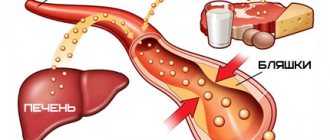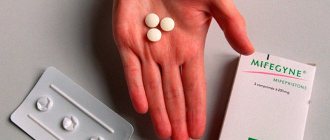The female body after 45 years
In women over 45 years of age, changes in the functioning of the hypothalamic-pituitary system are already beginning, and ovarian function decreases. The menstrual cycle is still regular, but rapid resorption of eggs occurs, and their number spontaneously decreases. Therefore, ovulation is not possible in every cycle. Due to the absence of the corpus luteum, insufficiency of the luteal phase occurs, menstruation begins to be periodically delayed, and sometimes breakthrough bleeding occurs.
At older ages, diseases of the reproductive system and other organs accumulate, hormonal imbalances often occur, and the risk of cancer pathologies increases. Therefore, contraceptive pills should be used with caution.
Reasons to continue taking birth control pills
Many people start taking birth control pills when they are young, and after 45 years they continue to do so out of inertia. There is a plus from continuous mode. Such women reliably protect themselves from unwanted pregnancy. If conception occurs at 45-50 years of age, you can carry and give birth to a child, but the risk of severe complications increases significantly . Therefore, gynecologists recommend not planning motherhood at this age.
Birth control pills are involved in maintaining normal hormonal levels. They do not allow the development of absolute or relative hyperestrogenism, which is to blame for the following diseases:
- endometrial hyperplasia;
- endometrial polyps;
- uterine fibroids;
- endometriosis.
If you take hormonal contraceptives before and after the age of 45, you can stop the progression of these diseases in the early stages.
Modern methods of preventing unwanted pregnancy
Contraception is the prevention of pregnancy through the use of contraceptives or methods.
In modern society of the civilized world, it is simply impossible to do without family planning. Of course, if we are talking about conscious adults, and not about marginalized people who reproduce to receive benefits and maternal capital, thanks to which they can not work and not deny themselves alcohol.
Every normal person, before having children, weighs his desires, possibilities and prospects, and only then, strictly speaking, begins to create offspring.
In order to make family planning as comfortable as possible, scientists have invented a very large number of means, each with its own pros and cons, and, importantly, effectiveness. Unfortunately, none of the creations of human hands existing today guarantees the absolute impossibility of fertilizing an egg, and therefore the onset of pregnancy.
Yes, despite all the latest advances in science, the only 100% reliable method of contraception is still one and only one - a glass of water. Not before, not after, but instead. That is, absolute abstinence. All other methods can fail at any moment and turn you into an expectant mother.
However, people are often let down not so much by the contraceptives themselves, but by forgetfulness, inattention, and the native Russian lack of love for instructions and reading them, and in this case this can be critical.
So, what modern contraception or methods of preventing unwanted pregnancy exist, and which ones to choose?
Natural or folk means of contraception.
1. The most reliable of all possible is complete abstinence.
. Of course, it suits few young and middle-aged people - children are children, and few people want to deprive themselves of a full life.
2. Coitus interruptus
– perhaps one of the most popular methods of contraception. Naive girls and boys, and even women and men, believe that the method is absolutely reliable if you have time to prevent ejaculation in the vagina. And of course, this has nothing to do with reality, since sperm leave the penis even before, so to speak, the end of the process. In fact, an interrupted PA is a traditional Russian custom - hoping for chance. What if it blows over? But it doesn’t always happen: according to US statistics, their supporters of this method become pregnant in 20 cases out of 100, that is, every two sexual acts out of 10 end with the woman turning into an expectant mother. Just think, one pregnancy for every 5 sexual intercourses! Obviously, if everything is fine with your intimate life and it is quite regular, this method is not suitable for you.
The number of pregnancies is associated with aging. Not the way you thought. December 1, 2020401
Barrier contraception that prevents sperm from entering the egg and fertilizing it.
3. Male condom
: is put on a certain place before sexual intercourse and does not allow sperm to enter the vagina. They are made from polyurethane or latex, so even people with allergies can choose a suitable option, and they are sold not only in pharmacies, but in almost every store.
The effectiveness of condom protection, according to the same American statistics, is about 82%, that is, approximately 18 out of 100 women can still become pregnant. The figure is sad, considering that this method is perhaps one of the most popular in the world. Well, or the second most popular after coitus interruptus.
The male condom is the only contraceptive available today that can prevent sexually transmitted infections.
4. Female condom
, or femidom, from “female” - woman, and “condom” - condom. Yes, there is such an intricate thing. It is made of polyurethane and has flexible rings at each end. One of them is fixed behind the pubic bone and allows you to hold the structure in its proper place, and the other remains outside the vagina. To increase the reliability of the method, they are recommended to be used in conjunction with spermicides that chemically kill sperm. The female condom is effective at a measly 79%, and therefore, because of this misunderstanding, 21% of the better half of humanity who use them get pregnant every year. For obvious reasons, this strange invention is more difficult to find than the traditional men's “product number 2”.
5. Contraceptive sponge
. The scheme for its use is simple - the same sperm-killing spermicide is applied to it, after which the sponge is inserted into the vagina with the correct side. Some of them have a special indentation to better stay on the cervix, and some are simply flat. The essence of the method is that the sponge itself acts as a physical barrier that does not allow sperm to break through to the egg, and the spermicide applied to it kills a decent number of “live ones.” The method, to put it mildly, is not the most reliable: from 12 to 24 out of 100 women who use it have every chance of becoming a mother unplanned. By the way, most often it does not work on women who have already given birth.
6. Diaphragm
- This is a rubber hemisphere that is placed above the cervix. Due to the hard flexible ring, it is pressed relatively tightly against the walls of the vagina. Just like the sponge and the female condom, it is recommended to use it with spermicide. In this case, the efficiency of the diaphragm will be approximately 88%, and without it - only 77-83%.
7. Neck cap
- This is another latex barrier product, shaped like a thimble, designed to prevent sperm from entering the uterus. Before insertion, you need to fill it with spermicide by about 1/3, and then manage to put it on the cervix. This is a dubiously pleasant procedure that requires considerable skill and sleight of hand, by the way. Due to suction, the structure should remain in place. Of course, if you place it correctly - and it’s unlikely to be possible to do this on the first try - do not make awkward movements, and God forbid, do not dislodge it. This is not the most reliable contraception - the effectiveness of the miracle invention is about 88% - this is if you use it with spermicide, and 77-83% - if you use it without it.
This is where barrier types of contraception end, and pharmaceutical ones
, that is, involving the use of achievements of chemical science.
8. Vaginal suppositories
– an extremely popular means of preventing unwanted pregnancy for women. They contain sperm-killing substances and require some time to dissolve, that is, they must be administered some time before sexual intercourse. They have an unpleasant feature - they can cause itching and a passionate desire to scratch in the most interesting place, and their effectiveness is rather modest - only 85%.
9. Contraceptive vaginal gel or cream
: the principle of their operation is exactly the same as that of candles, but since it reaches its destination already liquid, there is no need to wait until it starts working.
10. Contraceptive vaginal pills
- a slightly less common option, requiring much more time to dissolve than candles, but working on the same principle and with the same efficiency.
Marika Otkhozoria,
gynecologist, candidate of medical sciences, clinic “Medicine 24/7”
11. «Contraceptive injection
- this is an injection of a drug containing progestin - a synthetically created analogue of the hormone progesterone, which must be administered once every 3 months. The essence of the method is that progestin does not release the egg from the ovaries, preventing its maturation, or ovulation, and therefore pregnancy.
This method works in about 94% of cases, but over time, as the effect of the drug wears off, the likelihood of pregnancy increases.
Despite the fairly high effectiveness, this is not the most popular technique, since its side effects are quite noticeable. After using it, dizziness, bleeding, depression, abdominal pain and weight gain are possible.”
12. Intrauterine device
- This is a small flexible structure that is inserted into the uterus by a doctor. There are several types of such devices, operating on different principles. Non-hormonal IUDs come in three types: T-shaped, O-shaped and F-shaped. As the names suggest, each of them resembles a specific letter of the alphabet. They contain different substances - copper, gold or silver, with the most popular of them being copper. Their task is to kill the sperm, and in extreme cases, when fertilization does occur, to prevent such an egg from attaching and growing on the wall of the uterus. In addition, there are also hormonal IUDs containing the same progestin. They prevent sperm from entering the egg and fertilizing it by thickening the layer of cervical mucus that fills the cervical canal and thinning the wall of the uterus itself.
Intrauterine devices are installed for a fairly long period - 3, 5 or 10 years, depending on the type. Their efficiency is really high - it is more than 99%.
But even here there was a “fly in the ointment” - everything is not as simple with them as we would like. Firstly, they are not suitable for everyone due to the structural features of the body. Secondly, after their installation, perforation or damage to the muscular layer of the uterus is possible, and this is no joke. Thirdly, the method does not provide 100% protection against pregnancy; it can also fail, and if a woman decides to continue the pregnancy, the IUD can grow into the fetal tissue. In addition, the structure sometimes falls out, and with a high probability you will not find out about it right away - there will be a surprise. Well, you shouldn’t forget about side effects in the form of abdominal pain, heavy menstruation and the possibility of inflammatory diseases.
13. Birth control pills
There are two types - regular oral contraceptives, which contain two hormones: estrogen and progestin, or the so-called mini-pills, which contain only progestin. They are taken daily or with a break of one week - depending on the drug, the regimen may vary.
The principle of their action differs: the first prevent ovulation - the release of the egg from the ovaries, which occurs approximately on the 14th day of the cycle, the second - thin the mucous membrane of the uterus, and, on the contrary, thicken the layer of mucus in its cervix. The effectiveness of birth control pills under ideal conditions, which can be created in a laboratory, is as much as 99.7%. In real conditions, this figure is much more modest - only 91%, and then only in those cases if the woman takes them with discipline, literally hourly, and does not miss a single thing. Hormonal contraception is not at all harmless - it has side effects such as weight gain, fatigue, sore breasts, headaches and decreased libido. However, in addition to the disadvantages, they also have advantages: they help treat painful and too heavy menstruation, proliferation of the tissue lining the inner layer of the uterus, and ovarian cysts. In addition, according to recent data, they prevent ovarian and endometrial cancer.
Oral contraception is not compatible with many medications, such as some antibiotics, epilepsy medications, and St. John's wort.
Is it possible to get pregnant while taking birth control pills? December 17, 202034569 3
14. Contraceptive patch
, which is applied to the skin and releases the same hormones - estrogen and progestin. The patch is applied once a week for 3 weeks in a row, usually on the lower abdomen or buttocks, and the fourth week, when menstruation occurs, is skipped. The effectiveness of the patches, according to their creators, is 91%.
15. Vaginal ring
to protect against unwanted pregnancy: it is inserted into the vagina for 3 weeks, and on the fourth week, during menstruation, it is removed. It consists of flexible plastic and contains progestin and estrogen, which it releases gradually, in small doses. Like other remedies based on the action of these hormones, the ring prevents ovulation and thickens the mucus in the cervical canal, which prevents sperm from entering. Under ideal conditions, which of course cannot be achieved with normal use, it works in 99% of cases, but in real conditions - only in 91%, so that every 9 out of 100 women who use it have every chance of becoming a mother unplanned.
16. Subdermal contraceptive implant
– not the most common option in our country. It is a four-centimeter rod, approximately the size of an ordinary match, containing the same synthetically created hormone progestin, which is gradually released and enters the body in small doses. Without any incisions, it is carefully implanted under the skin in the shoulder area, and it can last up to 3-4 years. The implant can be removed at any time, after which ovulation will be restored and the woman can become pregnant if she wishes. This is a fairly effective contraception - it works in 99% of cases.
17. Emergency contraception
: pills that need to be taken after unprotected sexual intercourse or if you suspect that means of protection against unwanted pregnancy have not worked. The most popular such drug in our country is Postinor. It must be taken no later than 72 hours after everything happened. It will prevent ovulation, fertilization, or the attachment of a fertilized egg to the wall of the uterus. The effectiveness of protection against unwanted pregnancy when using this remedy is up to 95%, if you manage to use it within the first day, that is, 24 hours, and only 60% by the end of the third.
Emergency contraception after unsafe sex can have a serious impact on the body, so it is not advisable to use it often. In addition, some people believe that this is a kind of abortion, because the egg has already been fertilized - which, by the way, is actually the case. But if we go into details, then this may also include a considerable number of non-barrier means of protection, such as an intrauterine device or oral contraceptives, which do not allow the fertilized egg to attach to the wall of the uterus.
Permanent methods of contraception are sterilization.
18. Tubal ligation
: A rather serious and traumatic procedure, especially when compared to a vasectomy, a male version of sterilization. The surgeon will cut, tie, or otherwise manipulate the fallopian tubes, which carry the egg from the ovaries to the uterus, preventing the woman from becoming pregnant.
19. Tubal implant
, which the doctor places in the fallopian tubes, will cause the tissue surrounding it to grow, blocking them and preventing the egg from leaving the uterus and being fertilized. This process may take 3 months.
Female sterilization is traumatic because it is performed through an incision in the abdomen and stops the production of proper hormones, but it is effective in more than 99% of cases.
20. Vasectomy
- the male version of sterilization, much simpler in terms of consequences, is carried out quickly and practically painlessly: the doctor will cut or clamp the vas deferens, through which sperm moves from the testicles to the penis. After this, sperm will not be able to enter the ejaculate, and you will be able to enjoy your personal life without fear of an unplanned pregnancy. The method works in more than 99% of situations, and in the first years after surgery it can even be reversible, that is, not with 100% probability, but fertility, or the ability to conceive a child, can be restored to a man. You can read more about vasectomy in our separate article.
Vasectomy January 18, 20211847 6
Features and types of contraception after 45
To protect against pregnancy in women over 45 years of age, various types of hormonal contraceptives are used:
- combined oral contraceptives (COCs);
- pure gestagens, or mini-pills;
- subcutaneous implants;
- intrauterine hormonal system.
Not all methods of contraception are in demand after 45 years. Subdermal implants are not popular due to their invasiveness and the need for surgery. An intrauterine device with a hormone is recommended as a treatment for heavy menstruation, fibroids, endometriosis and endometrial hyperplasia. Birth control pills are the most popular. They are easy to dose and drink, but you need to strictly control the time of administration and not miss the next dose.
Mini-pill
Hormonal drugs for women over 45 years old from the mini-pill group are pure gestagens. They contain desogestrel. The mechanism of action is associated with thickening of cervical mucus, disruption of ovulation due to suppression of the release of LH and FSH. The endometrium does not undergo changes characteristic of the normal luteal phase. Representatives of the group are:
- Charosetta;
- Lactinet;
- Modell-mom.
Birth control pills with gestagens can be used by women who are contraindicated with birth control pills with estrogens. They are allowed to be drunk by smokers, with diabetes and pathologies of the cardiovascular system. But the contraceptive effect quickly disappears if you miss the time of taking the pill.
Combined oral contraceptives
Combined oral contraceptives after 45 years of age can be used only after a preliminary examination and consultation with a gynecologist. At this age, the number of diseases that are contraindications for birth control pills increases. Therefore, you must undergo the following examinations:
- general blood analysis;
- blood chemistry;
- coagulogram;
- mammography;
- Ultrasound of the pelvis;
- PAP test.
If the examination results are good and the woman does not have cardiovascular diseases, the doctor will select birth control pills.
Main indications for hormonal therapy
Hormonal drugs cannot be taken independently; they have a strict list of indications and are prescribed only by a doctor. Main indications for the use of glucocorticosteroids:
- Hormone replacement therapy normalizes well-being during menopause and eliminates unpleasant symptoms. For this purpose, products containing synthetic gestagens or progesterone are used.
- For the complex treatment of severe allergic reactions accompanied by inflammatory processes, prolonged cough, and the appearance of acne on the hands, face and body.
- If the reproductive system deteriorates, for successful fertilization.
- To restore hormonal balance and eliminate disturbances in the endocrine system after various surgical interventions.
- To prevent unwanted pregnancy in girls (emergency contraception - to terminate it).
Hormonal drugs are available in various pharmacological forms - drops for nasal congestion (Avamys, Nasonex) containing hydrocortisone, as well as ointments intended for the treatment of dermatitis, psoriasis and eczema (Advantan, Sinaflan, Akriderm).
Rules for choosing contraception after 45 years
Each drug has additional effects that are often used in gynecology. When choosing contraceptives for women after 45-50 years of age, they are guided by her state of health. Mini-pills are used in the following cases:
- excess weight;
- diabetes;
- arterial hypertension;
- smoking;
- tendency to thrombosis.
Everyone else can be prescribed birth control pills from the COC group. If an ovarian cyst is detected during an ultrasound, hormonal agents are not used until confirmation is received that it is a benign formation.
For mastopathy, long-term use of birth control pills is beneficial. The pills will only cause harm if there is a precancerous disease of the mammary glands or uterus.
Taking phytoestrogens during hormone therapy
For minor hormonal imbalances and mild menopause, phytoestrogens are prescribed. These are preparations containing hormone-like substances of plant origin. This is due to the fact that glucocorticosteroids have many contraindications and can cause side effects. Effective phytoestrogens for women:
- Remens;
- Estrovel;
- Klimadinon;
- Klimafem;
- Inoclim;
- Feminal;
- Qi-Clim.
Phytoestrogens can be produced in the form of tablets, homeopathic capsules, dietary supplements, and suppositories. They have a mild stimulating and regulating effect on hormonal levels in the body, activate metabolism and help prolong youth.
Plant phytoestrogens have fewer contraindications than hormonal drugs. They should not be taken if there is a tendency to thrombosis, malignant neoplasms and individual intolerance to the substances included in the composition.
How to take contraceptives after 45 years of age?
Women over 45 years old begin taking hormonal contraceptives from the first day of their period.
There are arrows on each package that you need to follow. You cannot skip a dose if the pill is forgotten; you must use the special rules that are printed in each instruction. If spotting and spotting occurs, you need to mark this day on the calendar so that later you can establish the regularity of the bleeding and find its cause. After the last 21 tablets, a break is taken for 7 days , during which menstrual-like bleeding appears.
Some doctors suggest extending the dosage regimen. In this case, the tablets are taken continuously from three packs for 63 days. After this, a break is taken for 7 days, during which bleeding is expected. This scheme reduces the likelihood of complications and side effects from birth control pills and has a beneficial effect on the woman’s condition.
Contraindications and side effects of birth control pills
For all drugs with an estrogen-progestin component, contraindications have been developed that are associated with a negative effect on the cardiovascular and coagulation systems. Mini-pills and COCs should not be taken after menopause and are not recommended for use as a method of emergency contraception. Other contraindications for birth control pills are:
- history of thrombosis and thromboembolism;
- diabetes mellitus (for COCs);
- migraine;
- severe pancreatitis;
- tumors and other severe pathologies of the liver;
- hormone-dependent tumors of the genital organs;
- vaginal bleeding of unknown origin;
- pregnancy;
- breastfeeding period (for COCs).
Birth control pills are more likely to cause adverse reactions in women over 50 years of age. Among them may be:
- mood swings;
- weight gain or loss;
- pain in the mammary glands;
- irregular uterine bleeding;
- decreased libido or complete loss;
- venous thrombosis.
Adenomyosis and fibroids are not contraindications for taking contraceptives, but some types of tumors respond to the supply of hormones and begin to progress.
It is much more difficult for women over 45 to lose weight. New generation contraceptives have virtually no effect on fat and carbohydrate metabolism, so their use is safe.
Hormonal imbalance during menopause and endometriosis
The main method of treating disorders that develop during menopause is taking glucocorticosteroids to normalize the hormonal balance in the body. They effectively eliminate unwanted symptoms and improve overall well-being.
In most cases, combination drugs with a predominant concentration of progesterone and a minimal amount of estrogen are prescribed. These include:
- Mastodinon;
- Klimaktoplan;
- Cyclodinone.
Hormone therapy is used for endometriosis, which is a hormone-dependent disease. Pharmaceuticals help reduce the production of estrogen and stop the further development of the disease.
Antigestogens, anabolic steroids, and combination drugs are used to treat endometriosis.
Hormonal contraceptive pills containing progestin components, selected exclusively by a gynecologist, can be an auxiliary treatment.
Rating of the best birth control pills after 45 years
You can choose a contraceptive after 45 years of age based on the list of the best modern drugs. They contain the optimal dosage of synthetic estrogen, and some contain natural estradiol valerate. This component is recommended for use by women of late reproductive age as it is safer.
No. 1 Yarina
A biphasic contraceptive based on 30 mcg ethinyl estradiol and 3 mg drosperinone. It has a pronounced antiandrogenic effect, which is indispensable for some older women. Often, after 40-45 years, the production of androgens increases, women notice that they have hair above the lip, hair growth on the arms and legs increases, the greasiness of the hair increases, and for some, it begins to fall out. You can reduce the negative impact of androgens with the help of Yarina. The package contains 21 tablets, they are taken according to the standard regimen with a 7-day break. The cost of packaging is about 1020 rubles.
№2 Femoden
Femoden contains gestaden 0.075 mg and ethinyl estradiol 30 mcg. This combination does not have androgenic activity, therefore it is allowed for use in women of late reproductive age. This contraceptive drug is also recommended for the following concomitant conditions:
- endometriosis;
- endometrial hyperplasia;
- menstrual irregularities;
- depression;
- decreased libido.
Package price from 700 rubles.
No. 3 Logest
The product also contains gestodene 0.075 mg and ethinyl estradiol, but in a reduced dose of 20 mcg. This combination is suitable for women with the following conditions:
- endometriosis;
- engorgement of the mammary glands while taking COCs;
- pain in the calf muscles when using birth control pills;
- heavy menstruation.
Contraindications, the regimen for taking Logest is similar to other birth control pills. Package price from 736 rubles.
No. 4 Tri-regol
This is a three-phase contraceptive. It contains ethinyl estradiol and levonorgestrel. This combination has low androgenic activity, so it does not provoke the appearance of hirsutism in women over 45 years of age. The packaging contains three types of tablets, in which the ratio of components varies. This will allow you to repeat changes in natural hormonal levels as much as possible and reduce side effects. Three-phase contraceptives are recommended for most women after 45 years of age, as well as for the following conditions:
- intermenstrual bleeding in the middle and beginning of the cycle;
- scanty menstruation;
- vaginal dryness;
- decreased libido;
- depression;
- gestagen-dependent side effects.
The price of the drug is from 166 to 731 rubles.
No. 5 Klaira
Contraception after 50 years with Qlaira is considered the most physiological. The product contains natural estrogen – estradiol valerate. It has the most beneficial effect on the condition of the endometrium and has moderate proliferative activity. Its action is complemented by dienogest. This component has an anti-androgenic effect, useful for women in later life.
The package contains 5 types of tablets, which are taken strictly according to the arrow. The first dark yellow ones contain only estradiol. Pink tablets contain estrogen in the same dose as gestagen. The following pale yellow tablets are predominantly progestogen, and the tap tablets again contain only estradiol. The latest white pills are pacifiers; they do not contain the hormone.
Qlaira is taken without interruption; after taking 28 tablets, a new pack is started . The price of the drug is from 1038 rubles per monthly dose to 2677 per package for 3 months.
Types of hormonal medications
When carrying out hormone replacement therapy, various groups of drugs are used to normalize hormonal balance and combat menopausal symptoms. They contain synthetic analogs of sex hormones produced in the human body. Effective and common hormonal drugs include:
| Pharmacological drug | Active substance | Manufacturer | average cost |
| Livial | Tibolone | Organon, Netherlands | 2400-2500 rubles |
| Estrofem | Estradiol | NOVO NORDISK A/S (Denmark) | 1300-1500 rubles |
| Trisequence | Norethisterone and estradiol | Novo Nordisk A/S DK-2880 Bagsvaerd, Denmark | 1800-2000 rubles |
| Proginova | Estradiol valerate | Schering SA is a subsidiary of Schering AG (France) | 540-600 rubles |
| Klimonorm | Levonorgestrel and estradiol | Alvogen IPCo Sarl (Luxembourg) | 730-850 rubles |
| Femoston | Dydrogesterone and estradiol | Solvay Pharmaceuticals B.V., The Netherlands. | 1100-1200 rubles |
| Duphaston | Dydrogesterone | Abbott Healthcare Products BV (Netherlands) | 520-700 rubles |
These glucocorticosteroids include estradiol esters, micronized forms of progesterone and estradiol, as well as conjugated estrogen from horse urine and its synthetic analogues.










